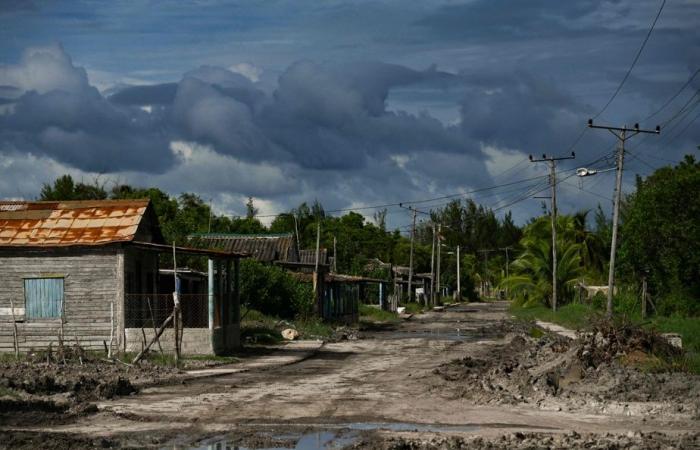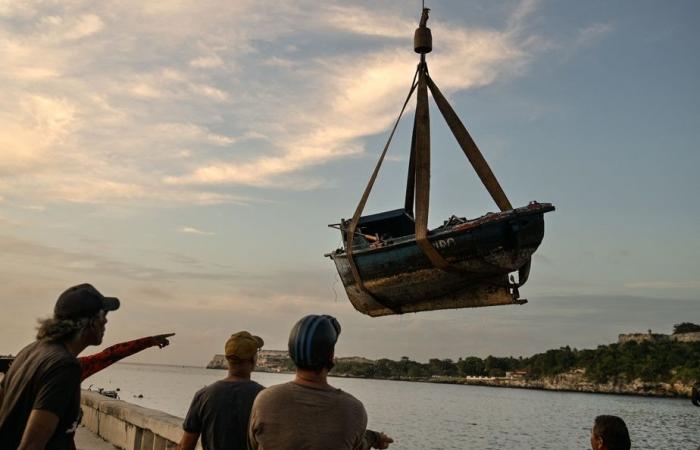(Havana) The hurricane Rafael was raised to category 3 as it prepares to hit the west coast of Cuba, already affected two weeks ago by a giant electrical outage and the passage ofOscar.
Posted at 8:41 a.m.
Updated at 2:57 p.m.
Jordane BERTRAND
Agence France-Presse
« Rafael becomes a Category 3 hurricane as it approaches the coast of western Cuba,” the US Hurricane Center (NHC) said on X.
The hurricane is expected to cause “life-threatening flooding, destructive winds […] and flash floods” in this area of the country, added the American agency.
“Severe hurricane with maximum sustained winds of 185 km/h”, which makes it a category 3 out of 5 hurricane according to the Saffir-Simpson scale, “may further strengthen before making landfall in the afternoon » Wednesday, confirmed the Cuban Meteorological Institute (INSMET) on the same social network.
At 1 p.m., the hurricane was 165 km south of Havana and moving at 22 km/h, according to the NHC.
Faced with this new threat, the Cuban authorities have increased calls for vigilance and preventive measures “to protect the population and safeguard material resources”.
“We are in constant communication with the territories that will feel the effects of the hurricane the most Rafael “, declared Cuban President Miguel Diaz-Canel on Wednesday on X. “Courage Cuba! “, he said.
Nine provinces (out of the country’s fifteen), located in the west and center of the island, including that of Havana, have been placed on “cyclonic alert”.
Furthermore, the “National Defense Council”, made up of soldiers, was activated on Tuesday to respond to the meteorological emergency situation.
In Havana, where two million inhabitants live, the vast majority of whom had deserted the streets on Wednesday where businesses, offices, schools were closed, the rains and gusts became more intense as the day progressed, noted the AFP.
PHOTO ADALBERTO ROQUE, AGENCE FRANCE-PRESSE
Fishermen remove boat from water before hurricane arrives Rafael.
In the village of Alquizar, located about fifty kilometers southwest of the capital, Liset Herrera, 57, told AFP on Tuesday that she feared that after the passage of Rafael“there will be nothing left” of his village.
“People, even if they are not evacuated, are leaving [d’eux-mêmes]because it’s very difficult,” lamented Marisol Valle, a 63-year-old farmer, in the coastal village of Ganimar, a few kilometers further south.
Shelter
Shelter operations were carried out in various provinces of the country involving several tens of thousands of Cubans, particularly in the west and center of the country.
Around 13,000 people were notably placed under protection in the central province of Villa Clara, according to the official press, which however specified that the alert had been lifted in the province of Guantanamo (East), the hardest hit by the hurricane Oscar.
The latter, category 1, hit the east of the island on October 20 before transforming into a tropical storm. Severe flooding surprised residents of two locations in Guantanamo, San Antonio del Sur and Imias, where eight people died.
Oscar occurred while the island was suffering a general blackout. For four days, Cuba’s ten million residents were without power due to a giant blackout that broke out on October 18 following fuel shortages and a breakdown at the country’s main power plant. .
On Wednesday, the availability of electricity “will depend a lot on the effects of the hurricane,” Lazaro Guerra, director of electricity at the Ministry of Energy and Mines, told Cuban television.
Last week, the Minister of Energy and Mines, Vicente de la O Levy, recognized that the situation of the electricity system remained “tense” on the island, while load shedding has continued chronically since then in the whole country.
In September 2022, the island had already experienced a widespread power outage after the passage of powerful Hurricane Ian which hit the west of the island.
Rafael is expected to weaken over Cuba, but will still be a hurricane as it enters the southeastern Gulf of Mexico, according to the NHC.







